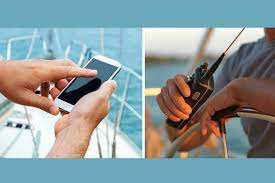
Dear Ms. Smartphone: I was having a drink at my favorite restaurant- it overlooks the Bay and we placed our order from tablets on each table. The wait staff was taking orders from a boat tied up to the dock. They called in from a built-in device that looked like a walkie-talkie on a cord. I am thinking of getting a small boat this summer and it made me wonder if boaters need smartphones at all? Yves
Dear Yves: The thirsty people on the boat were using their Marine VHF radio instead of a cell phone. It uses a VHF band (very high frequency) reserved for marine traffic. It allows instant communication between boats, marinas, bridges, and occasionally, ship to shore restaurants! But it’s most important function is to keep boater’s safe and maintain an ongoing connection with the Coast Guard.
Even if you plan to stay close to shore and will always have land in sight, having a VHF radio is an essential safety tool on a boat. It is as important as having one flotation device (the life jacket) for everyone onboard. A sailing magazine called Latitude38 recently had a special section on using VHF radios and I urge you to read it before you get your boat. You can tune into different “channels” on a VHF radio, including continuous weather updates. The restaurant you were at must get a lot of boaters dropping by, so they were prepared for this type of call. Certain channels on these phones are reserved for non-essential calls and chit chat. But it isn’t what the VHF system was designed for.
VHF Floats the Boat:
Although smartphones replace the need for many other digital devices, they will not replace the VHF marine phone. The VHF radio creates an “augmented reality” (my term) between your boat and the surrounding waters or harbor. On designated channels, a skipper hears what’s around her, both on and under the water. The one-to-many communications is unlike a smartphone. It provides a way to alert crew on other boats if there’s a safety issue. It’s also a way to communicate your bearings to request the opening of a draw bridge or filling of a lock. Importantly, you’ll hear chatter over the VHF radio if there are whales or other large mammal sightings.
But the most typical use is staying in touch with the Coast Guard, and the Coast Guard staying in touch with you (Channel 16). They can inform you over the VHF radio about unexpected weather/ tide conditions that impact your safety. If there is a boat in distress or a man overboard the Coast Guard will be streaming to the site after getting the MayDay call. But if your vessel is closer to the distressed site, you will be expected to be a first responder. Also, a marine radio will send and receive signals where smartphones cannot- after all, it’s a big ocean. One of the most vital functions is to send a boat’s GPS coordinates (providing that’s hooked up). Hopefully you will never have to use the VHF radio in this way.
Good for pictures:
Redundancy is preferred in communication, so it’s still a good idea to take a smartphone along, in a waterproof case of course. You might want to take a scenic picture from the blue waters or just call back to shore! But lots of cell phones get wet, react badly to salt water, and go for a swim. The VHF radio is far more durable and has a special-purpose design. It takes a few quick lessons to learn the procedures and remember which channels to monitor or talk on. Unless your boat is never going to leave the dock, take a short course in how the VHF radio operates, and practice using it so you will be prepared. Make sure your new boat comes equipped with one and then as the expression goes never leave home- i.e. the dock- without it.
